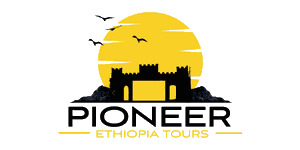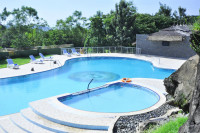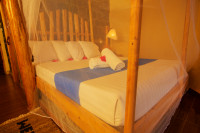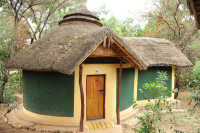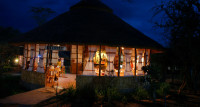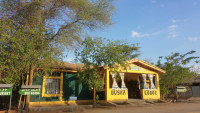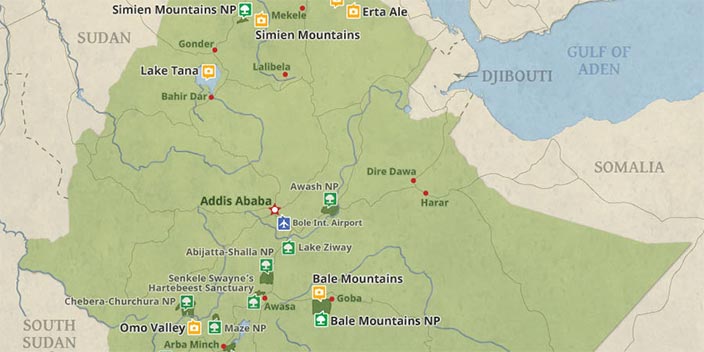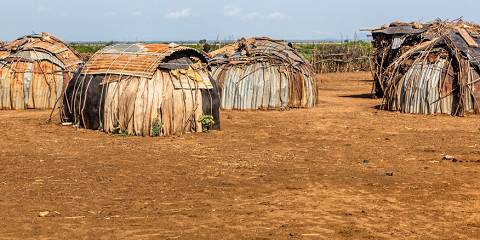
$2,200 pp (USD)
2 travelers on Start dateArrival
Arrival

Day 1-2
Arrive in Arba Minch, visit Doeze Village and over night at Paradise Lodge
Arrive in Arba Minch, visit Doeze Village and over night at Paradise Lodge
The Dorze huts are one of the most remarkable aspects of the village. The tall, beehive-shaped structures are made from bamboo and enset (false banana) leaves. Despite their height, these huts are designed to be portable and can last up to 80 years. The Dorze are renowned for their weaving skills producing some of the finest textiles in Ethiopia. they use hand-spun cotton to create beautiful scarves, shawls, and traditional garments. The vibrant colors and intricate patterns of their textiles are highly valued and sold in markets across the country. The Dorze people rely on enset (false banana) as a staple food. Visitors to Dorze Village can experience various traditional practices, including the preparation of of enset-based foods, local music, and dance performances. The Dorze Village also offers stunning panoramic view of the surrounding landscape, including Lake Abaya and Lake Chamo. Dorze Village is a popular stop on cultural tours in Southern Ethiopia.
- Main Destination:
- Arba Minch (City)
- Accommodation:
- Paradise Lodge
- Meals & Drinks:

Day 3-4
Drive to Turmi, visit Hamar Community, and over night at Turmi Lodge
Drive to Turmi, visit Hamar Community, and over night at Turmi Lodge
Turmi Village is a small, yet culturally rich settlement located in the Southern part of Ethiopia, within the Omo Valley. It is primarily inhabited by the Hamar people, one the most well-known and culturally distinctive ethnic groups in Ethiopia. Turmi Serves as a central hub for exploring the traditions and way of life of the Hamar people and is a key destination for cultural tourism in the region. The Hamar are renowned for their unique customs, colorful attire, and elaborate hairstyles. Women typically wear intricately styled hair with ochre, butter, and beads, and they dress in goatskin garments adorned with beads and cowrie shells. Men also have distinctive hairstyles and are often seen carrying traditional wooden stools, which they use as both a seat and pillow. One of the most significant cultural practices of the Hamar people is the bull-jumping ceremony, a rite of passage for for young men transitioning into adulthood. The Hamar are also skilled in beadworks and pottery.
- Main Destination:
- Turmi (Lower Omo Valley)
- Accommodation:
- Turmi Lodge
- Meals & Drinks:

Day 5-6
Trip to Omorate to visit Dassanech Community
Trip to Omorate to visit Dassanech Community
Omorate Village is a remote settlement in the Omo Valley. It lies along the banks of the Omo River and is primarily inhabited by the Dassanech people, one of the many indigenous ethnic groups in the region. Omorate serves as an important cultural and trading center and is a key destination for travelers interested in exploring the unique cultures of the Omo Valley.
The Dassanech are a semi-nomadic pastoralist community, known for their resilience and adaptability in the harsh, arid environment of the Omo Valley. They traditionally herd cattle, goats, and sheep, and their livelihoods are closely tied to the seasonal floods of the Omo River, which they use for farming crops like sorghum and maize. - Omorate is a destination for cultural tourism, attracting visitors interested in experiencing the lifestyle of the Dassanech people. Guided tours often include the opportunities to witness daily activities, and participation in or observation of cultural ceremonies of Dasaanech people.
- Main Destination:
- Omorate (Lower Omo Valley)
- Accommodation:
- Buska Lodge
- Meals & Drinks:

Day 7-8
Trip to Korcho Village to visit Karo Community
Trip to Korcho Village to visit Karo Community
Korcho Village is a small, traditional settlement located in the Omo Valley of southern Ethiopia. It is primarily inhabited by the Karo (or Kara) people, one of the least numerous ethnic groups in the region. Despite their small population, the Karo are renowned for their intricate body painting, scarification practices, and distinctive cultural expressions. Perched on a high plateau overlooking the Omo River, Korcho Village offers stunning views of the surrounding landscape and provides an immersive experience into the unique lifestyle of the Karo people.
The Karo people are known for their elaborate body painting and scarification, which are central to their cultural identity. Both men and women use white chalk, red ochre, yellow mineral rock, and charcoal to create striking patterns on their bodies, often in preparation for ceremonies or social events. Korcho Village is a popular destination for tourists interested in experiencing the diverse cultures of the Omo Valley.
- Main Destination:
- Arba Minch (City)
- Accommodation:
- Turmi Lodge
- Meals & Drinks:

Day 9
Visit to Nechisar National Park
Visit to Nechisar National Park
Nechisar National Park is one of the country's most scenic and ecologically diverse parks. The park is named after the Nechisar plains, which are a prominent feature of the park. The landscape includes grasslands, savannah, and lush forests. The scenic beauty of the park and the serene atmosphere of the area offers lifelong experience to those travelers who are involved in sightseeing and nature walks. The park is bordered by two of the largest Rift Valley lakes: Lake Abaya to the north and Lake Chamo to the south. These lakes are separated by a narrow strip of land known as the "Bridge of God."
Nechisar National Park is home to a variety of wildlife, including some endemic and rare species. Among the mammals, you can find zebras (including the Burchell's zebra), Grant's gazelles, Swayne's hartebeest, and greater kudu. - The lakes are rich in aquatic life, with hippos and crocodiles being common sights. In particular, Lake Chamo is famous for its large population of Nile crocodiles.
- Main Destination:
- Arba Minch (City)
- Accommodation:
- Paradise Lodge
- Meals & Drinks:

Day 10
Morning Arba Minch City Tour and Nature Walks
Morning Arba Minch City Tour and Nature Walks
Arba Minch is known for its stunning natural beauty, rich culture, and strategic location in the Ethiopian Rift Valley. The name "Arba Minch," meaning "Forty Springs" in Amharic, reflects the town’s famous underground water springs that contribute to its lush, green environment.
Arba Minch is renowned for its numerous natural springs, which emerge from the ground in and around the town. These springs have historically provided fresh water to the town and its surroundings, making the area fertile and green. The springs also feed into the nearby lakes, supporting both agriculture and wildlife.
The town is strategically located between two of Ethiopia’s largest lakes, Lake Abaya and Lake Chamo. Lake Abaya is characterized by its reddish-brown waters, while Lake Chamo is known for its clearer waters and abundant wildlife. The narrow strip of land between the two lakes is called the "Bridge of Heaven" or "God's Bridge," and offers breathtaking views of the surrounding landscape.
- Main Destination:
- Arba Minch (City)
- Accommodation:
- No accommodation (End of tour)
- Meals & Drinks:

